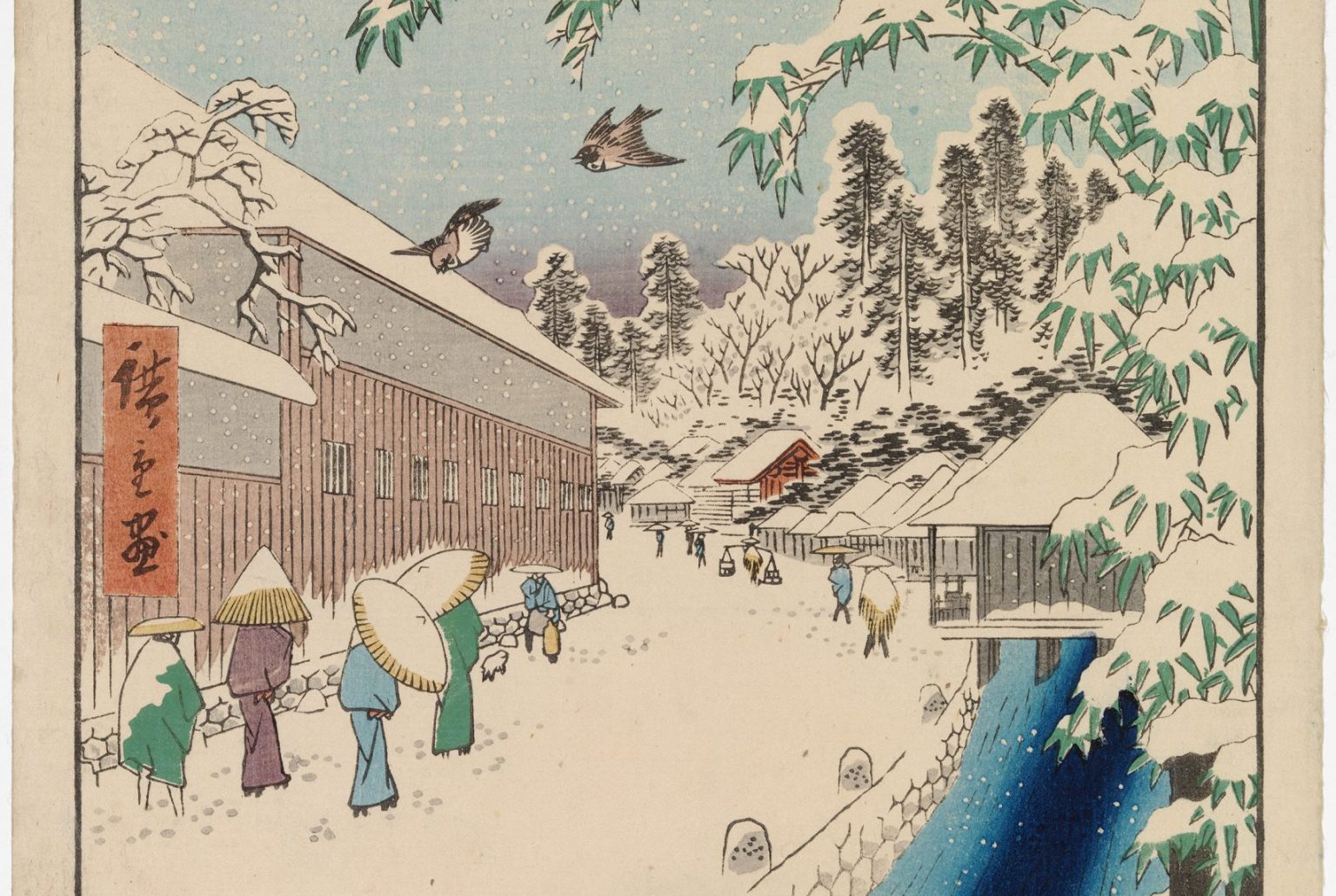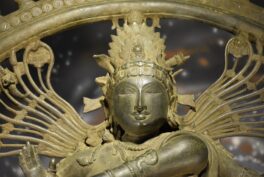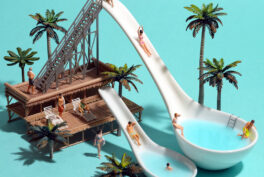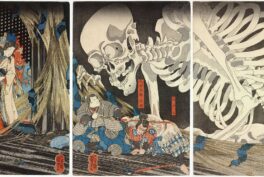Summary
This is an overview of 10 words and 4 schools of painting that reflect the life and culture of the Edo period.
Shogun
Edo period began when Tokugawa Ieyasu became the shogun and settled his capital in the city of Edo (modern Tokyo). Shogun was what we would today call a military dictator, but they were still appointed by the emperor. While the emperor and his court held all the prestige, it was the shogun who held the power and effectively ruled the country. The title of shogun was practically hereditary and, during the Edo period, it remained within the Tokugawa family. A shogun ruled with the help of officials known as bakufu (幕府, “tent government”).
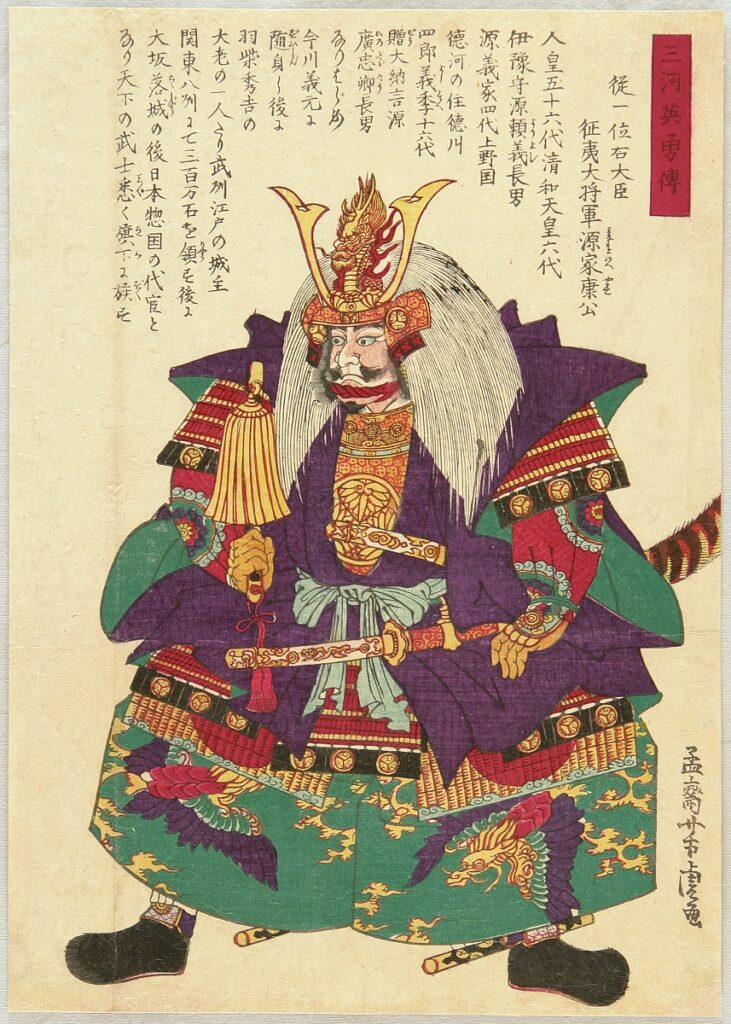
Utagawa Yoshitora, The First Shogun of the Tokugawa Shogunate from Mikawa Eiyu Den (Heroes of Mikawa Province), 1873. Artelino.
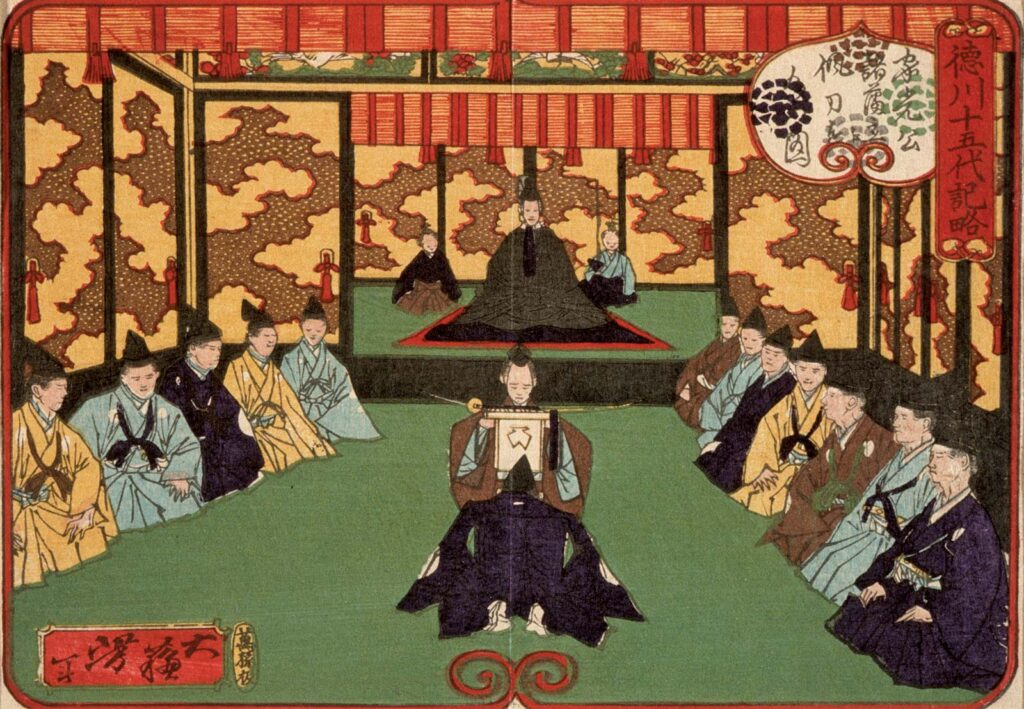
Tsukioka Yoshitoshi, The Tokugawa shogun Iemitsu receiving lords (daimyo) in an audience, 1875, Los Angeles County Museum of Art, Los Angeles, CA, USA. Britannica.
Daimyo
Daimyos were fundamental to the shogun’s power. Japan, during the Edo period, was a feudal state and daimyos owned the land. Divided into three groups depending on their proximity to the Tokugawa family, they were responsible for local government in their domains. Initially, the taxes levied on the peasants made them very rich, but gradually the lavish lifestyle made many of them indebted to the merchants, who interestingly were not taxed as one of the lowest classes of Japanese society. The state thought it distasteful to tax such parasitic activities as trade.
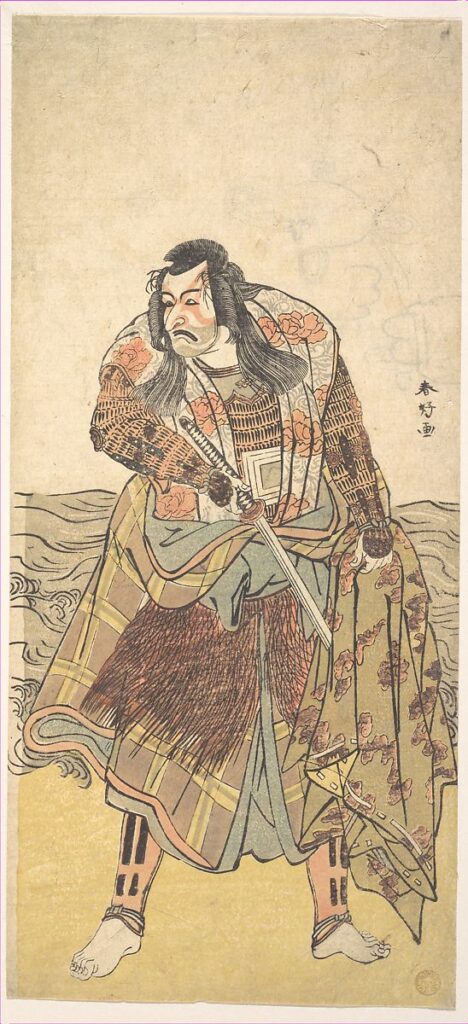
Katsukawa Shunkō, The Fifth Ichikawa Danjuro as a Samurai, ca. 1785, The Metropolitan Museum of Art, New York, NY, USA. Museum’s website.
Samurai
Samurai were soldiers, some of them reporting directly to the shogun, others kept as retainers by daimyos. Samurais didn’t own the land and didn’t work, for it would be beneath them. Combat was their only occupation, but in a period as peaceful as the Edo period, there wasn’t that much fighting to do, so many samurais devoted their time to arts. It was common for samurai to be well-educated and enjoy social privileges. Shortly after the Edo period, their role became obsolete, as it was much cheaper to have conscript soldiers that we know from the modern armies. But they utilized the experience gained during the Edo period in managing daimyos’ estates and many of them moved into business and professional roles.
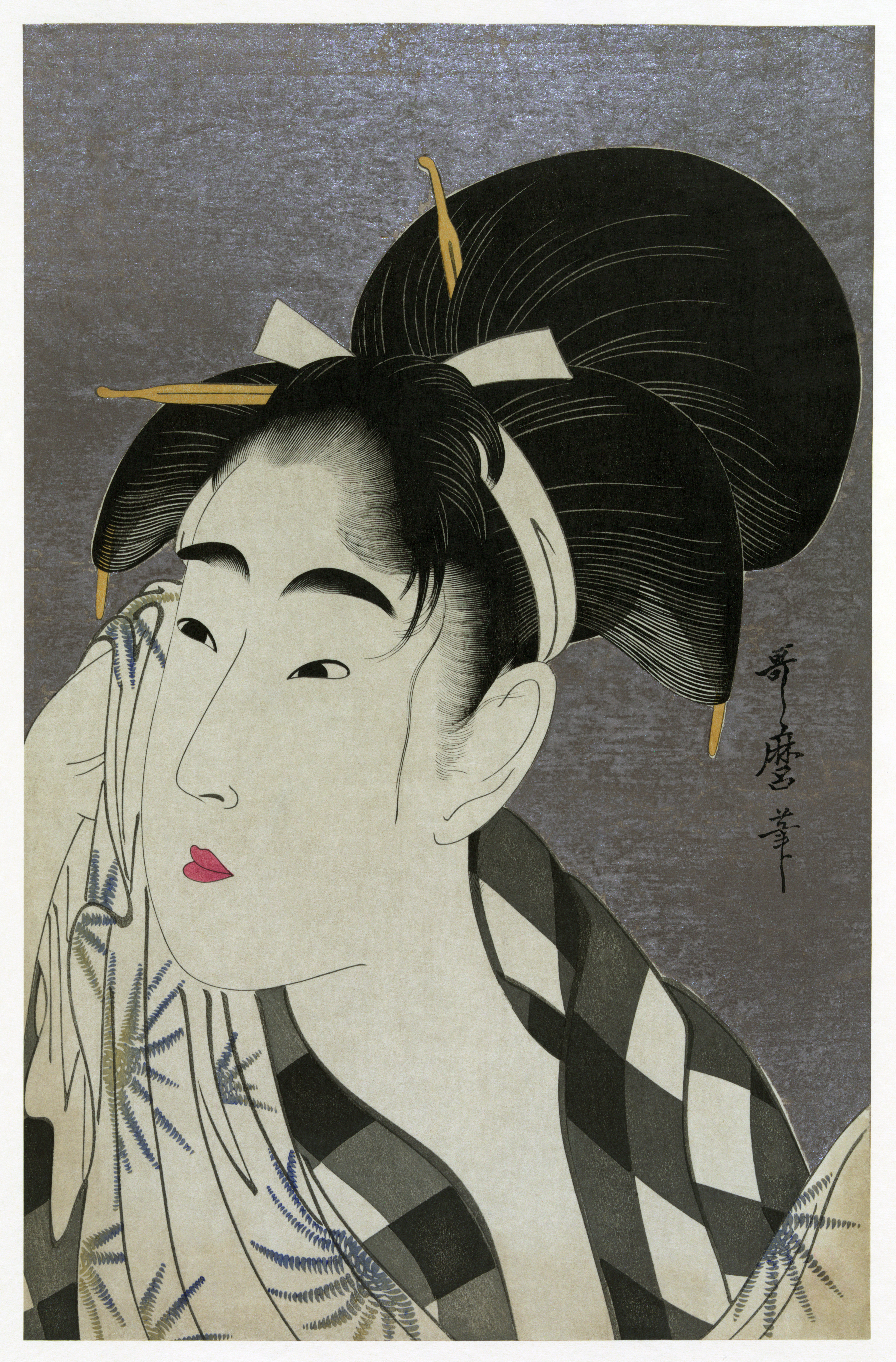
Kitagawa Utomaru, Ase o fuku onna (Woman wiping sweat), 1798, printed between 1918 and 1923, Library of Congress, Washington, DC, USA. Wikimedia Commons (public domain).
Sankin-kōtai
Sankin-kōtai was a policy that helped shoguns keep their friends close and enemies even closer. It mandated the daimyos to spend every other year in Edo, as well as mandated their families to permanently live there. It allowed for easier connection to the central power but was also a subtle form of holding hostages in case the daimyos would scheme an uprising. For the shogunate, it had the added benefit of draining daimyos’ financial resources by maintaining two lavish residences; this further assured they would not wage war.
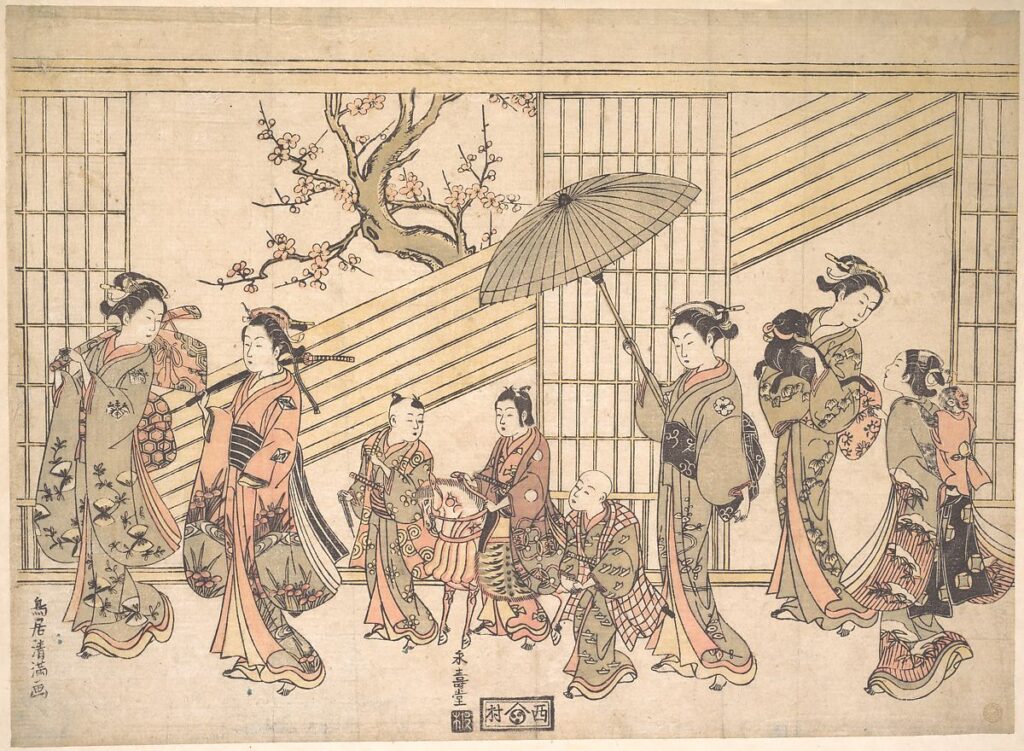
Torii Kiyomitsu, Children Play-acting a Daimyo Procession, ca. 1763, The Metropolitan Museum of Art, New York, NY, USA. Museum’s website.
Sakoku and Rangaku
Edo period was also a time of great isolationism in Japan. Sakoku was a doctrine that aimed at keeping Westerners out of Japan. From the 1630s, foreigners were not allowed to step on Japanese land, and breaking this rule was punishable by death on the spot. Also, any Japanese wanting to leave the country were not allowed to come back. At certain times during the Edo period, shipbuilding was banned. It does not mean that there was no foreign trade, however. There was extensive trade with China through the port of Nagasaki, in the far west of Japan, with a residential area for the Chinese. The policy stated that the only European influence permitted was the Dutch factory at Dejima in Nagasaki. This presence did not break the rules of sakoku, because Dejima was an artificial island, and hence not considered part of Japan.
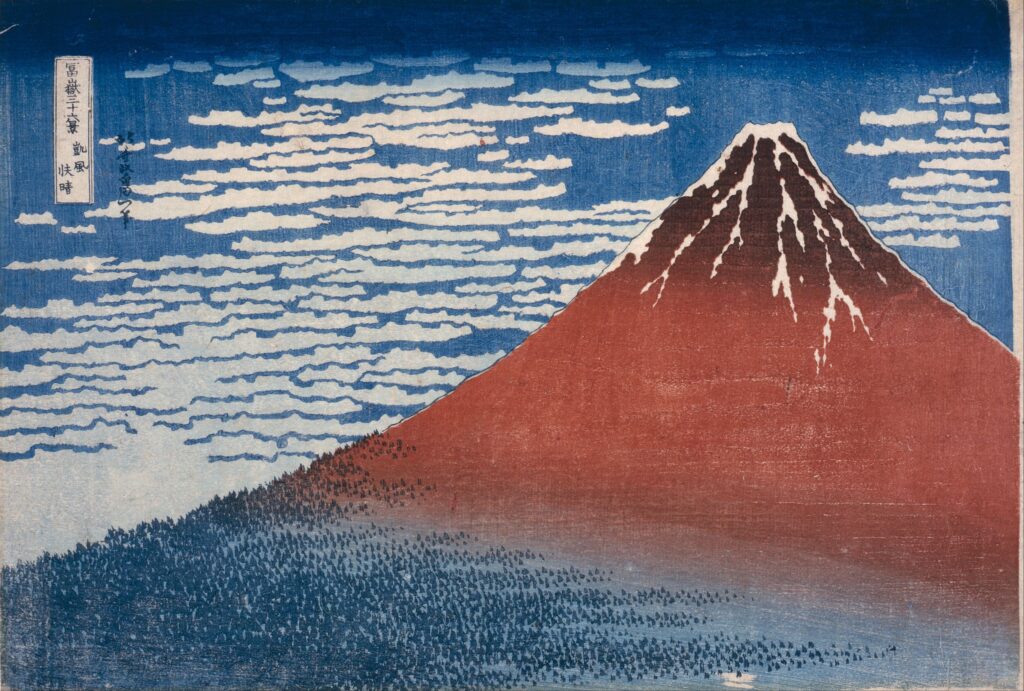
Katsushika Hokusai, Gaifū kaisei (Fine Wind, Clear Morning) from Thirty-six Views of Mount Fuji, ca. 1800-1849, Indianapolis Museum of Art, Indianapolis, IN, USA. Wikimedia Commons (public domain).
And this is where we get to Rangaku (“Dutch learning”). As much as Japan wanted to keep the outsiders out, it was still keen to learn of the progress their enemies were making. Rangaku was a body of knowledge developed by Japan through its contacts with the Dutch and the enclave of Dejima, which allowed Japan to keep abreast of Western technology and medicine. It helped Japan during the Meiji Restoration to catch up very quickly with Western progress.
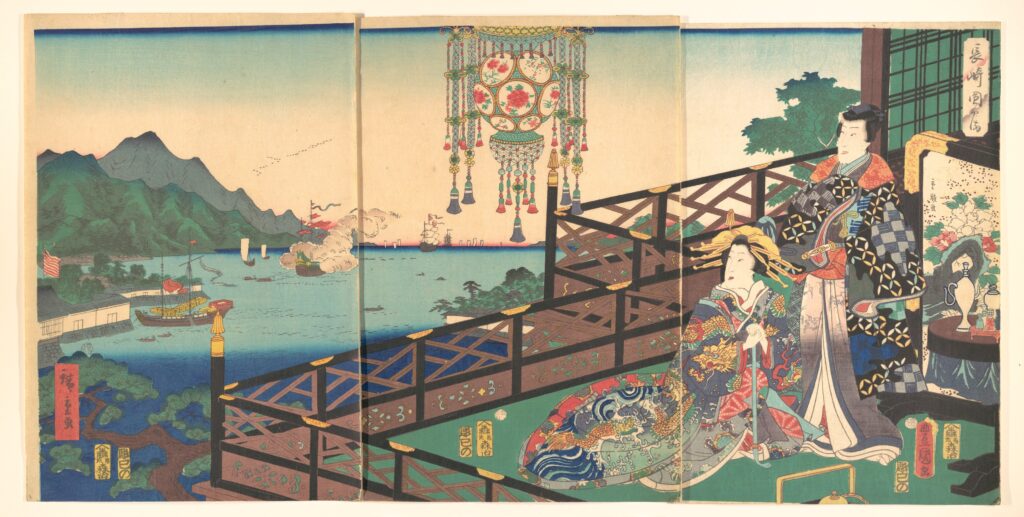
Utagawa Kunisada, Mitsuuji in the Maruyama Pleasure District of Nagasaki (Nagasaki dejima), 1861, The Metropolitan Museum of Art, New York, NY, USA. Museum’s website.
Hankō and Terakoya
I already mentioned that samurai were well-educated. In general, the population of Japan during the Edo period was relatively cultured, especially in the higher echelons. Hankō, or han schools were established to educate the children of daimyos and samurais in the local feudal domains. Those were state schools and, initially, the curriculum focused on Confucian studies. With time, however, access to schools was broadened beyond the daimyo and samurai, and the curriculum was significantly extended to cover training in classical Japanese studies, medicine, and the various branches of Western learning including mathematics, astronomy, military science, and ballistics.
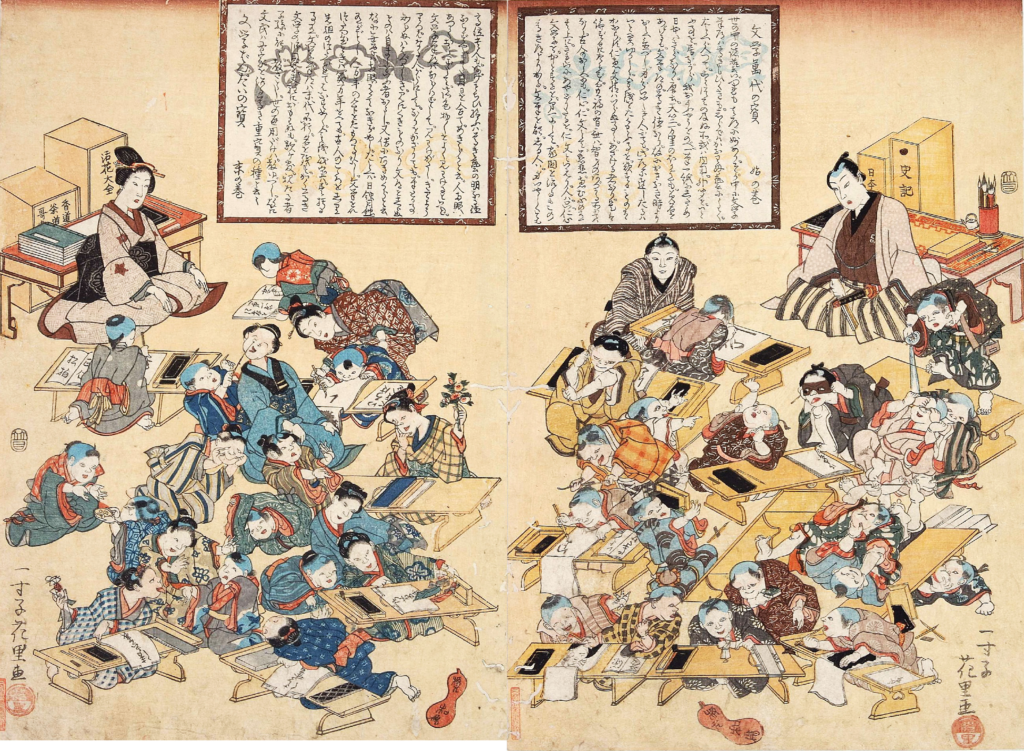
Issunshi Hanasato, Terakoya from The Timeless Treasures of Literature, 1844-1848, Tokyo Metropolitan Library, Tokyo, Japan. Wikimedia Commons (public domain).
Terakoya were different from hankō in that they were private schools aimed at the common folk, mostly merchants, who had the money but were low in society. Initially, the schools were often existing within the Buddhist temples, but later they also often found space in the private homes of the upper classes. The curriculum began with calligraphy courses and then grew to include counting with the abacus, history, and geography. They taught about the daily lives of people, household precepts, conversation skills, and moral values, as well as historical and geographical topics, which showed a wider scope of social life to the students.
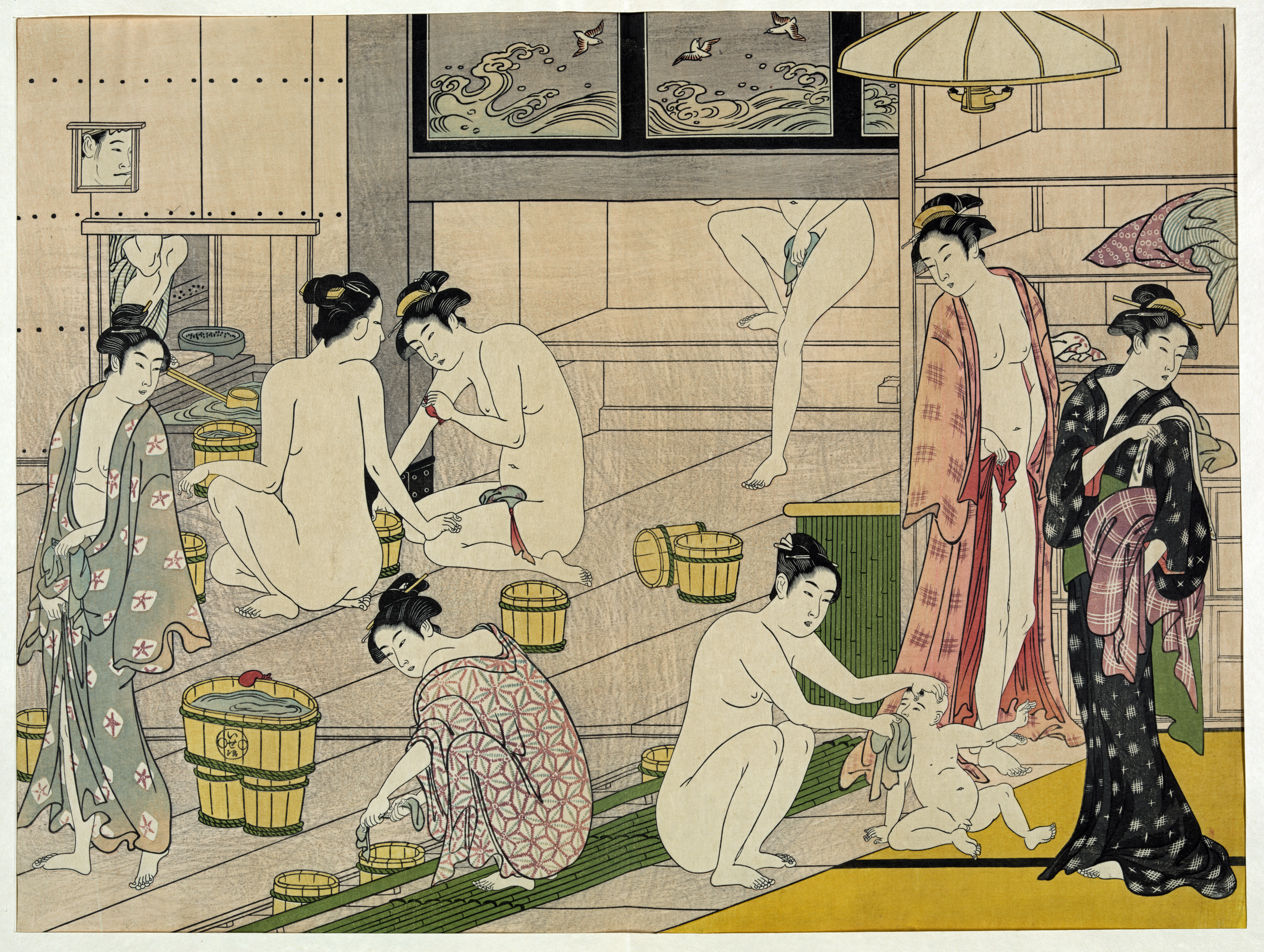
Torii Kiyonaga, Onna yu (Bathhouse women), c. 1780, Library of Congress, Washington, DC, USA. Wikimedia Commons (public domain).
Ukiyo
Ukiyo, meaning “the floating world”, is a term used to describe the urban culture that developed during the Edo period. During that time, especially when the higher classes moved to the cities, peace combined with economic progress allowed for the development of the culture of leisure. The merchant classes, positioned at the bottom of the social order, benefited the most from Edo’s rapid economic growth, and began to indulge in and patronize the entertainment of kabuki theatre, geishas, and courtesans of the pleasure districts; the term ukiyo came to describe this hedonistic lifestyle. Ukiyo culture developed in Yoshiwara, the licensed red-light district of Edo. It was a culture focused on the enjoyment of life and pleasure.
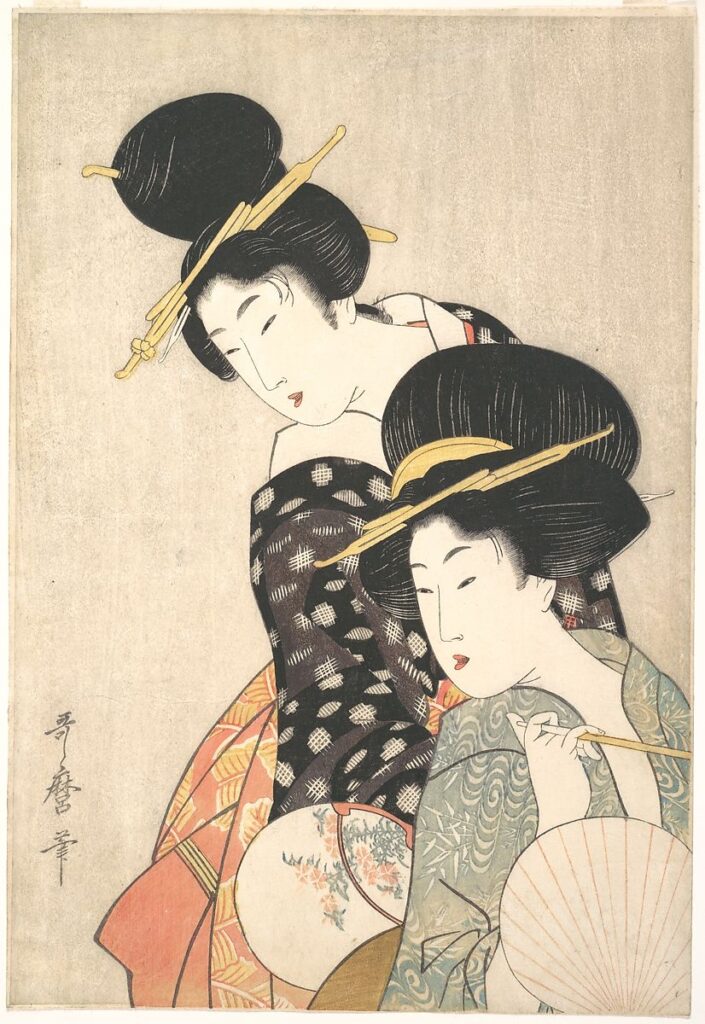
Kitagawa Utamaro, Two Women, c. 1790, The Metropolitan Museum of Art, New York, NY, USA. Museum’s website.
Ukiyo-e
Ukiyo-e is a style of woodblock prints that developed with the rise of ukiyo culture. The subject matter ranged from female beauties; kabuki actors and sumo wrestlers; scenes from history and folk tales; travel scenes and landscapes; flora and fauna; and erotica or scenes of gore. Hishikawa Moronobu was one of the first representatives of this style in its mature form. His prints were monochrome or colored by hand, but color printing soon followed. By the 18th century, the works of such titans as Torii Kiyonaga, Utamaro, and Sharaku were popularized. The tradition continued in the 19th century with such accomplishments as The Fifty-three Stations of the Tōkaidō by Hiroshige or Hokusai’s The Great Wave off Kanagawa. Sadly with the death of those two masters and the end of the Edo period, the days of ukiyo-e ceased.

Utagawa Hiroshige, Kawasaki: The Rokugo Ferry from Fifty-three Stations of the Tōkaidō, ca. 1833-1834. Christie’s.
Kabuki
Kabuki as a theatrical genre developed very early in the Edo period. It is thought to have originated with a female dance troupe founded by Izumo no Okuni, which is interesting given that in 1629 women were banned from performing in kabuki. It is known for its heavily-stylized performances, the often-glamorous costumes worn by performers, and the elaborate kumadori make-up worn by some of its performers. Kabuki was often performed in Yoshiwara and formed an integral part of the culture of ukiyo. The widespread appeal of kabuki often meant that a diverse crowd of different social classes gathered to watch performances, a unique occurrence that happened nowhere else in the city of Edo.
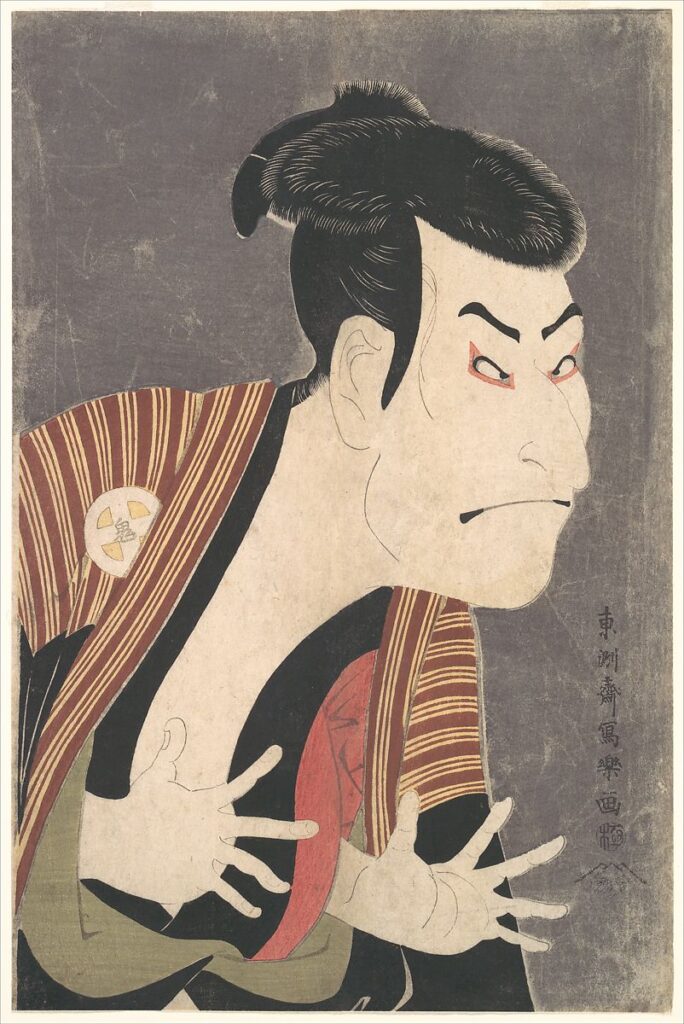
Tōshūsai Sharaku, Kabuki Actor Ōtani Oniji III as Yakko Edobei, 1794, The Metropolitan Museum of Art, New York, NY, USA. Museum’s website.
Bunraku
Bunraku is a form of traditional Japanese puppet theatre, founded in Osaka at the beginning of the 17th century. The performance includes three types of artists: Ningyōtsukai or Ningyōzukai – the puppeteers, the tayū – chanters, and shamisen, the musicians.
The heads and hands of traditional puppets are carved by specialists, while the bodies and costumes are often constructed by puppeteers. The heads can be quite sophisticated technically In plays with supernatural themes, a puppet may be constructed so that its face can quickly transform into that of a demon. Less complex heads may have eyes that move up and down, side to side or close, and noses, mouths, and eyebrows that move. Bunraku shares many themes with kabuki. In fact, many plays were adapted for performance both by actors in kabuki and by puppet troupes in bunraku. Bunraku is particularly noted for lovers’ suicide plays. The story of the 47 rōnins is also famous in both bunraku and kabuki.
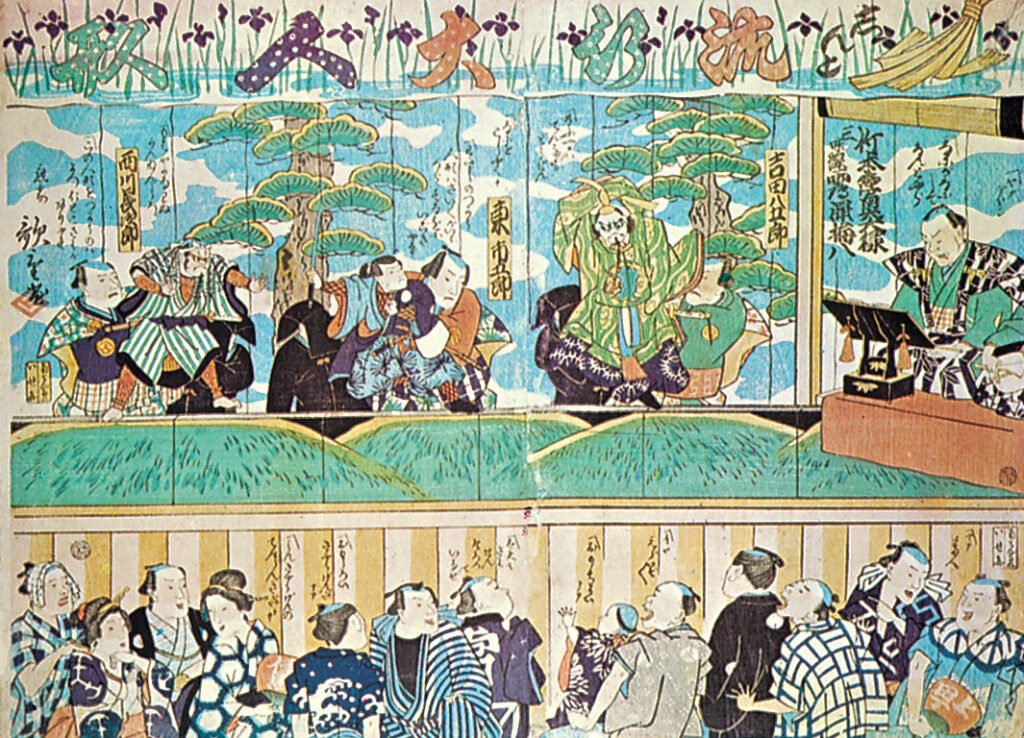
Utashige, Japanese Bunraku theatre, c. 19th century. Britannica.
Now let’s take a closer look at the four schools of visual arts that developed during the Edo period in addition to ukiyo-e.
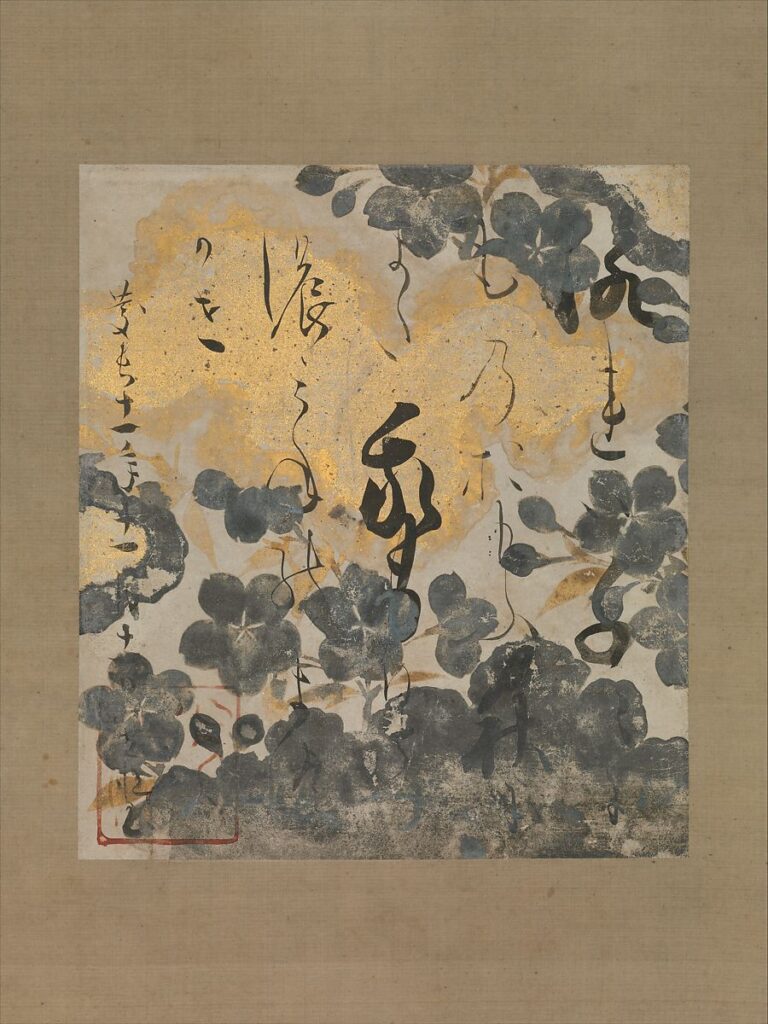
Hon’ami Kōetsu, Poem by Kamo no Chōmei with Underpainting of Cherry Blossoms, 1606, The Metropolitan Museum of Art, New York, NY, USA. Museum’s website.
Rinpa School
Rinpa school developed in the early Edo period, mostly in answer to the growing demand for art from the merchant classes. Rinpa artists worked in various formats, notably screens, fans, hanging scrolls, woodblock-printed books, lacquerware, ceramics, and kimono textiles. The subject matter and style were pretty conservative. Often including simple natural subjects such as birds, plants, and flowers with the background filled in with gold leaf. Two of the most important participants of the Rinpa school were Hon’ami Kōetsu (1558–1637) and Tawaraya Sōtatsu (died ca. 1640). These men collaborated successfully to combine Kōetsu’s graceful calligraphy written on top of Sōtatsu’s decorative paintings, producing objects with a strong sense of rhythm, pattern upon pattern, and refined elegance.

Tawaraya Sōtatsu, Hon’ami Kōetsu, Anthology with Cranes, ca.1602-1620, Kyoto National Museum, Kyoto, Japan. Wikimedia Commons (public domain).
The Rinpa school was revived in the Genroku era (元 1688–1704) by Ogata Kōrin and his younger brother Ogata Kenzan, sons of a prosperous Kyoto textile merchant. Kōrin’s innovation was to depict nature as an abstract, using numerous color and hue gradations, mixing colors on the surface to achieve eccentric effects, and liberally using precious substances like gold and pearl. Transmitted by means of pattern books and manuals, the work of the Ogata brothers inspired numerous other craftsmen.
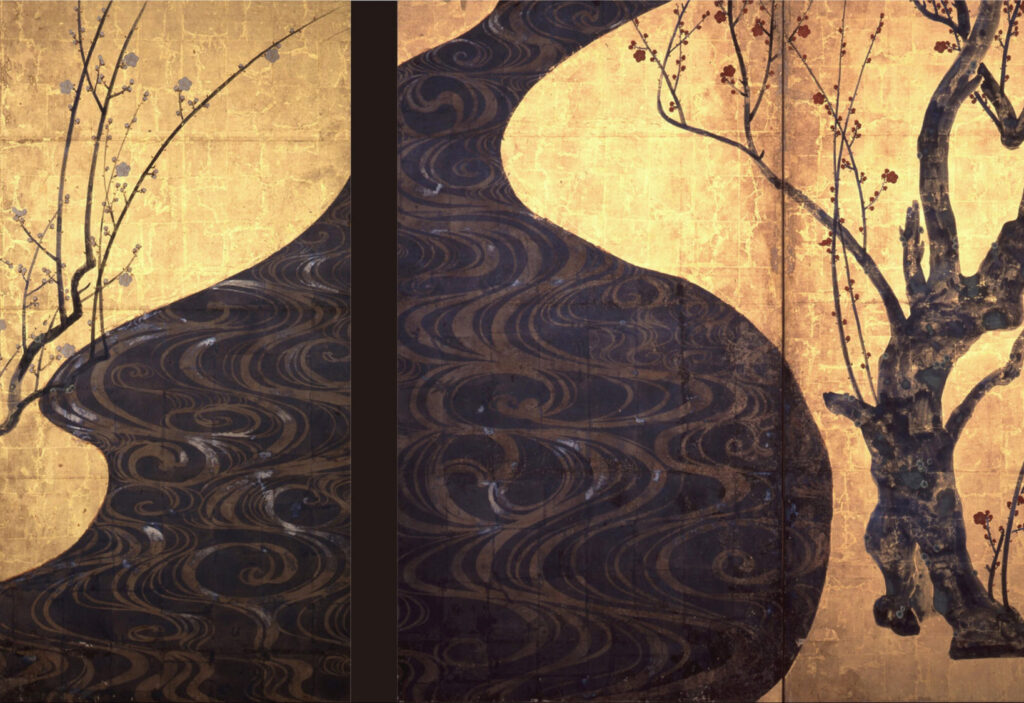
Ogata Kōrin, Red and White Plum Blossoms, c. 18th century, MOA Museum of Art, Atami, Japan. Wikimedia Commons (public domain).
Kanō School
The Kanō school is one of the most famous schools of Japanese painting. The Kanō school of painting was the dominant style of painting from the late 15th century until the Meiji period. The school began by reflecting a renewed influence from Chinese painting, and it continued to produce monochrome brush paintings in the Chinese style over the years. However, it simultaneously developed a brightly colored and firmly outlined style for large panels, which reflected distinctively Japanese traditions. The school was supported by the shogunate, effectively representing an official style of art. Kanō painters worked primarily for the nobility, shoguns, and emperors, covering a wide range of styles, subjects, and formats.
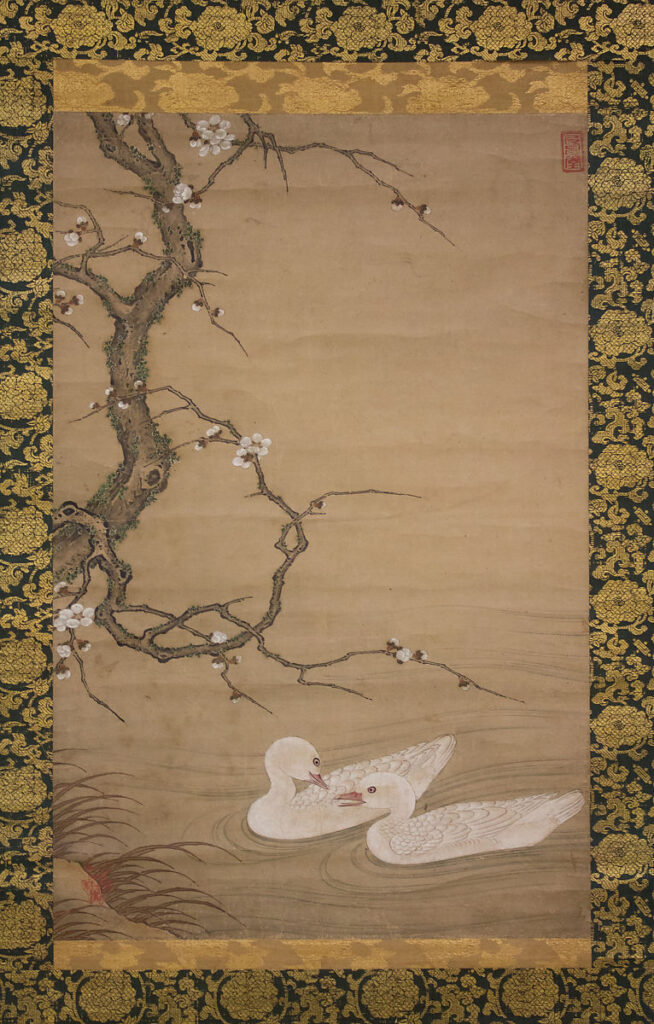
Kanō Masanobu (attributed), Plum Tree and Waterfowl, c. 16th century, The Metropolitan Museum of Art, New York, NY, USA. Museum’s website.
The school was founded by the very long-lived Kanō Masanobu (1434–1530), who was the son of Kagenobu, a samurai and amateur painter. Masanobu trained his sons Kanō Motonobu (1476–1559) and the younger Yukinobu (or Utanosuke). Kanō Eitoku (1543–1590), a grandson of Motonobu and probably his pupil, was the most important painter of this generation and is believed to have been the first to use a gold-leaf background in large paintings.
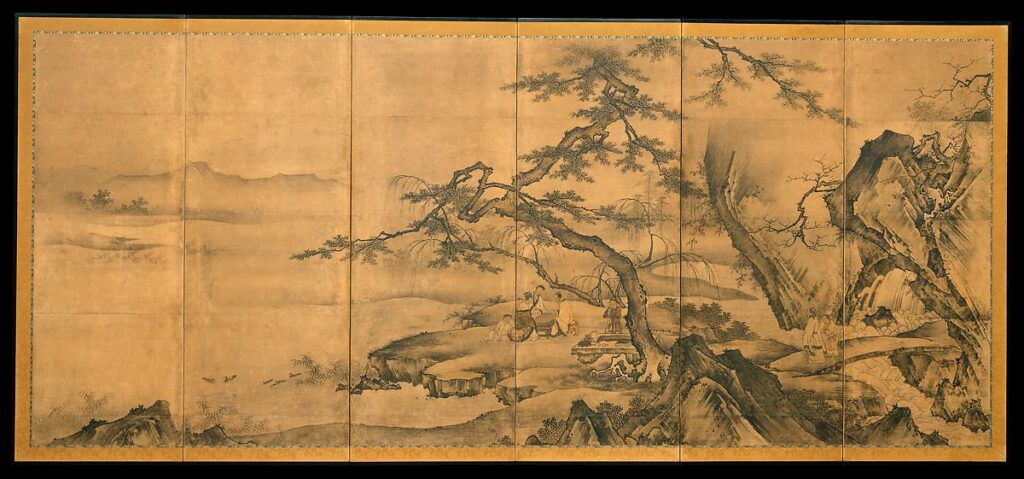
Kanō Motonobu, The Four Accomplishments, c.16th century, The Metropolitan Museum of Art, New York, NY, USA. Museum’s website.
Bold and vigorous styles using bright colors on a background in gold leaf or paint appealed to the taste of these patrons and were applied to large folding screens (byōbu) and sets of sliding doors (fusuma). Common subjects were landscapes, often as a background for animals and dragons, birds, trees or flowers, or compositions with a few large figures, but crowded panoramic scenes from a high viewpoint were also painted.

Kanō Sanraku, Pair of screens with tigers scared by a storm-dragon, 17th century, Myoshinji-temple, Kyoto, Japan. Wikimedia Commons (public domain).
Bunjinga or Nanga School
Another important art trend during the Edo period was the Bunjinga or Nanga school, a kind of literati painting highly influenced by China literati. This genre started as an imitation of Chinese scholar-amateur painters of the Yuan Dynasty, whose works and techniques came to Japan in the mid-18th century. The paintings—usually in monochrome black ink, sometimes with light color, and nearly always depicting Chinese landscapes or similar subjects—were patterned after Chinese literati paintings wenrenhua (文人畫). Poetry or other inscriptions were also an important element of these paintings and were often added by friends of the artist, rather than the artists themselves.
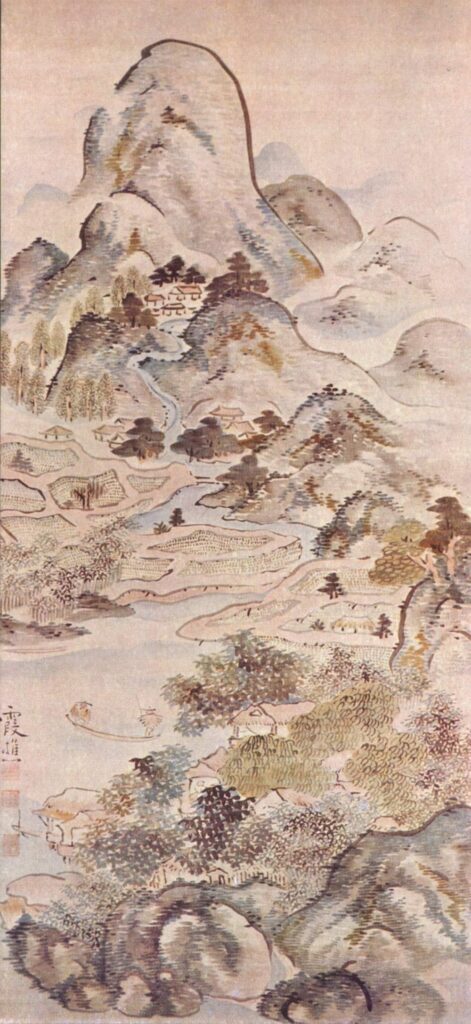
Ike no Taiga, Fishing in Springtime, 1747, Cleveland Museum of Art, Cleveland, OH, USA. Wikimedia Commons (public domain).
Representatives of this style include Ike no Taiga, Uragami Gyokudo, Yosa Buson, Tanomura Chikuden, Tani Buncho, and Yamamoto Baiitsu.
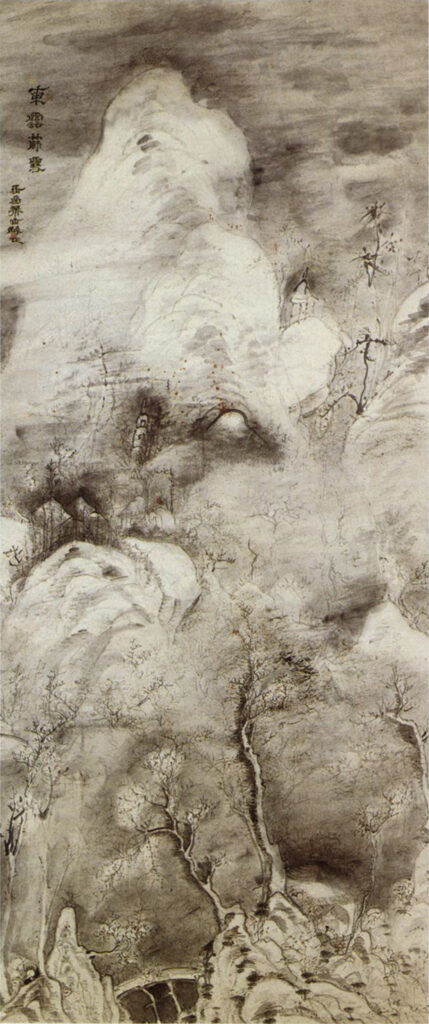
Uragami Gyokudo, Snow Sifted Through Frozen Clouds, 19th century, Kawabata Foundation. Wikimedia Commons (public domain).
Zenga
Zenga is the Japanese term for the practice and art of Zen Buddhist painting and calligraphy which developed during the Edo period. In many instances, both calligraphy and image will be merged within the same piece. The calligraphy denotes a poem or saying that teaches some element of the path of Zen; the brush painting is characteristically simple, bold, and abstract. In keeping with individual paths to enlightenment, nearly any subject matter can and has lent itself to Zenga; however, the most common elements depicted were the ensō, sticks, and Mt. Fuji. In Zen Buddhism, an ensō is a circle that is hand-drawn in one or two uninhibited brushstrokes to express a moment when the mind is free to let the body create. The ensō symbolizes absolute enlightenment, strength, elegance, the universe, and mu (the void), and it is characterized by a minimalism born from Japanese aesthetics.
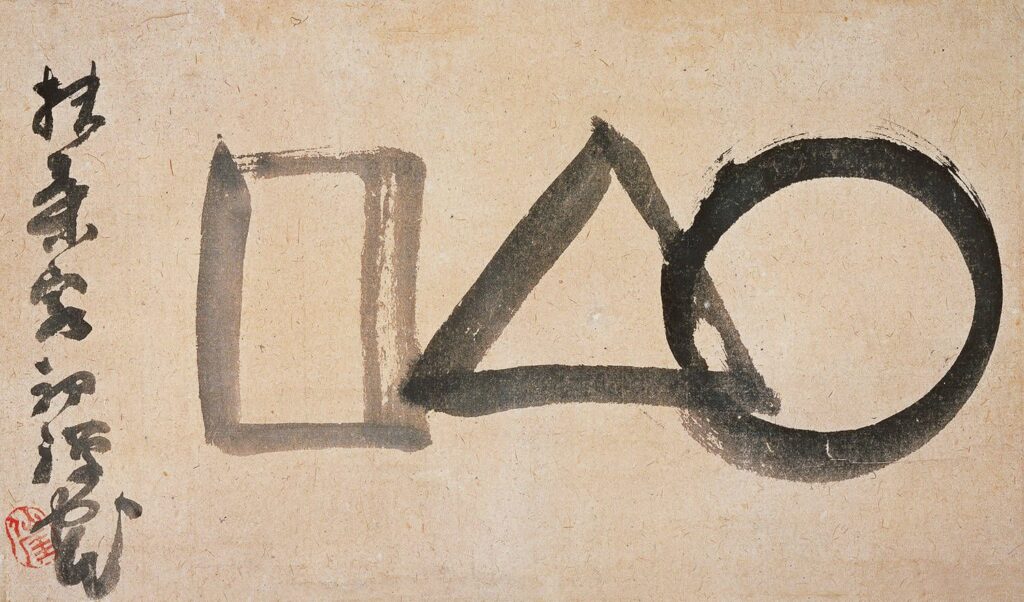
Sengai Gibon, Fusō saisho zenkutsu (Japan First Zen Cave), 1750-1837. Terebess.
With a period so culturally rich as Edo, it is difficult to summarize it in a few paragraphs, but hopefully the above gave you a quick glimpse into that time. And whet your appetite to explore more about this fascinating time when Japan closed its borders to outsiders and flourished within itself. The art they created was so deeply influential that it heavily impacted artists in the West.
